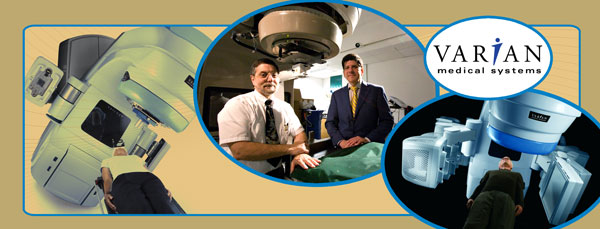Tumor Team

Tumors are moving targets.
Movements as subtle as breathing or digestion can change their locations. What’s more, tumors are often irregularly shaped, which makes it even more challenging for physicians to precisely hit them with beams of radiation — a technique known as radiosurgery.
But accuracy is essential. Millimeters are miles in the human body.
No one understands this better than William A. Friedman, chair of UF’s Department of Neurosurgery, and neurosurgery Professor Frank Bova, who have been working together since 1988 to invent tools and techniques to destroy tumors.
Along the way, they have gathered data from more than 3,000 patients and published more than 150 peer-reviewed papers.
Their most recent advances involve the latest generation of the UF radiosurgery system, the Trilogy Tx™ medical
linear accelerator, developed by Varian Medical Systems of Palo Alto, Calif., using technology perfected at and licensed to the company by UF.
The treatment involves delivering precisely focused, high-energy radiation to a patient in a single treatment session. The intent is to destroy malignant or non-malignant tumors or to make other medical repairs that cannot be addressed by conventional surgery.
As part of its partnership with Varian, Shands at UF was chosen as the site for the first treatments with the
Trilogy Tx™ machine in July 2006.
Patients with disorders ranging from malformations in the circulatory system to metastatic brain tumors have been treated with the machine at Shands and it has been installed at more than 100 treatment centers around the world.
As hoped, the new technology has led to shorter treatment times.
“We are able to complete some of the simpler treatments in just seven minutes,” Bova says. “If you include the time spent getting the patient into position and performing final checks, these treatments required only 15 minutes. Similar treatments would often take 30 to 45 minutes, using older technology. That’s a long time to lie still for treatment.”
In addition to speeding the process, another advantage of the Trilogy Tx ™ is that its radiation beam can be shaped to precisely match the dimensions of a tumor, making it possible to deliver a high dose of radiation without harming surrounding normal tissue.
“It would be wonderful if all tumors were the same shape,” Friedman says. “But if you have anything but a circular tumor, you have to do some very intricate planning to make sure the radiation shape fits precisely.”
And because tumors can move, the device has a built-in onboard targeting system that employs two CT scanners. The Trilogy Tx ™ uses software developed at UF to combine magnetic resonance scans with CT scans that are done at the time of treatment.
Friedman says this advance will enable doctors to use radiosurgical techniques long commonplace in brain treatments on other parts of the body.
“This is really the leading edge of a revolution in the way radiation therapy is currently used,” Friedman said.
The $3 million machine uses UF-developed software to automatically plan the doses.
“Trilogy is the first machine that is engineered for delivering these types of treatments,” Bova says. “It is an order of magnitude more accurate than our previous machine. It allows us to target with much more confidence, to reduce our treatment margins, to get closer to critical structures near the target and know that we’ll be able to avoid them.”